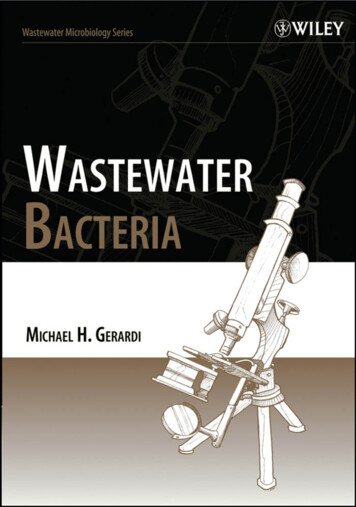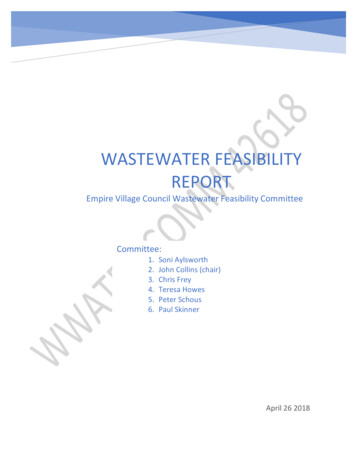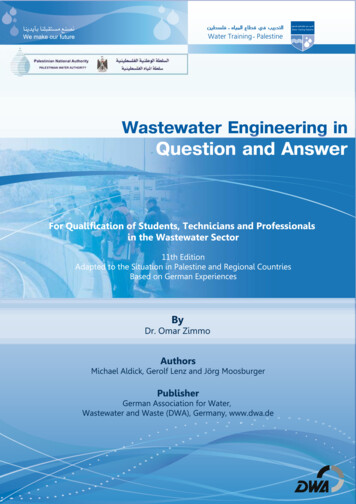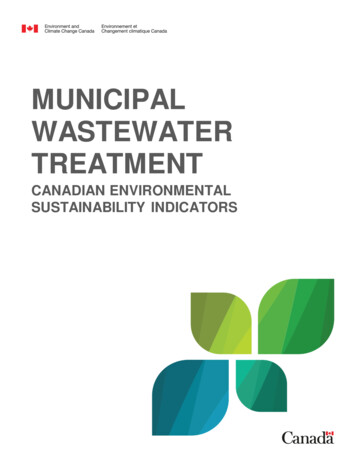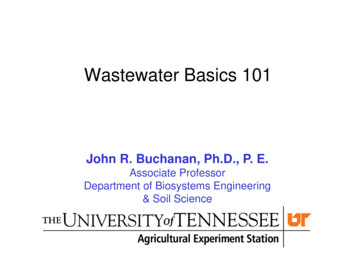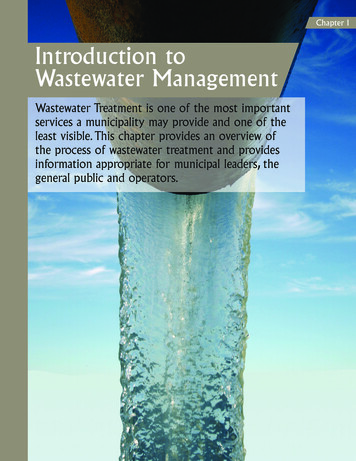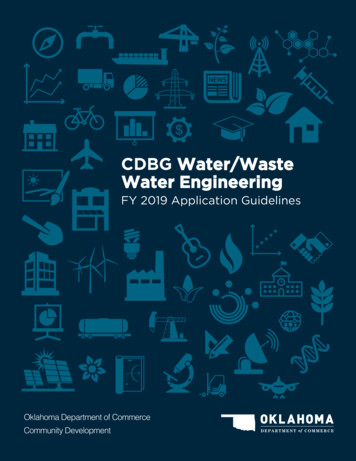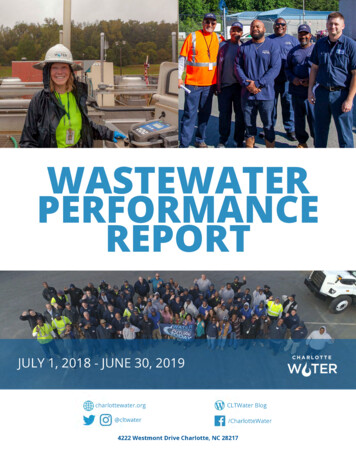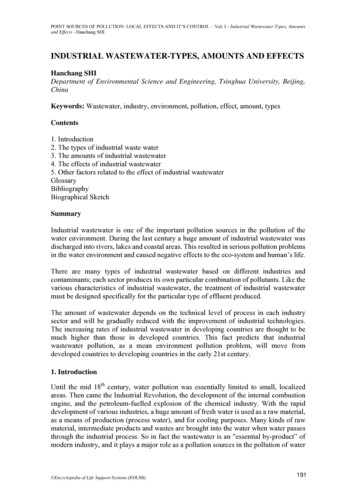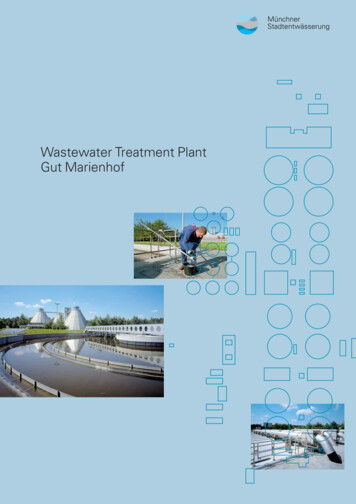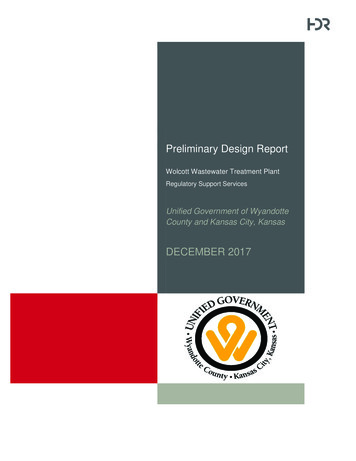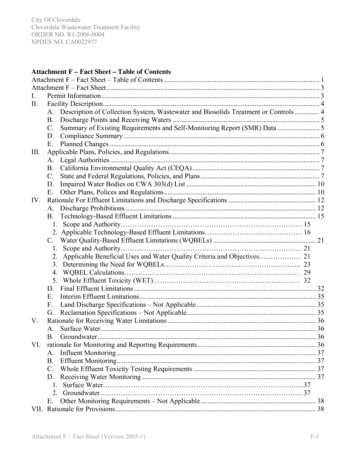
Transcription
City Of CloverdaleCloverdale Wastewater Treatment FacilityORDER NO. R1-2006-0004NPDES NO. CA0022977Attachment F – Fact Sheet – Table of ContentsAttachment F – Fact Sheet – Table of Contents . 1Attachment F – Fact Sheet. 3I.Permit Information. 3II. Facility Description. 4A. Description of Collection System, Wastewater and Biosolids Treatment or Controls . 4B. Discharge Points and Receiving Waters . 5C. Summary of Existing Requirements and Self-Monitoring Report (SMR) Data . 5D. Compliance Summary . 6E. Planned Changes . 6III. Applicable Plans, Policies, and Regulations. 7A. Legal Authorities. 7B. California Environmental Quality Act (CEQA). 7C. State and Federal Regulations, Policies, and Plans . 7D. Impaired Water Bodies on CWA 303(d) List . 10E. Other Plans, Polices and Regulations. 10IV. Rationale For Effluent Limitations and Discharge Specifications . 12A. Discharge Prohibitions . 12B. Technology-Based Effluent Limitations . 151. Scope and Authority 152. Applicable Technology-Based Effluent Limitations 16C. Water Quality-Based Effluent Limitations (WQBELs) . 211. Scope and Authority 212. Applicable Beneficial Uses and Water Quality Criteria and Objectives 213. Determining the Need for WQBELs . 234. WQBEL Calculations 295. Whole Effluent Toxicity (WET) 32D. Final Effluent Limitations . 32E. Interim Effluent Limitations. 35F. Land Discharge Specifications – Not Applicable . 35G. Reclamation Specifications – Not Applicable. 35V. Rationale for Receiving Water Limitations . 36A. Surface Water . 36B. Groundwater. 36VI. rationale for Monitoring and Reporting Requirements. 36A. Influent Monitoring . 37B. Effluent Monitoring. 37C. Whole Effluent Toxicity Testing Requirements . 37D. Receiving Water Monitoring. 371. Surface Water .372. Groundwater 37E. Other Monitoring Requirements – Not Applicable . 38VII. Rationale for Provisions. 38Attachment F – Fact Sheet (Version 2005-1)F-1
City Of CloverdaleCloverdale Wastewater Treatment FacilityORDER NO. R1-2006-0004NPDES NO. CA0022977A.B.1.2.3.4.5.6.Standard Provisions. 38Special Provisions . 38Reopener Provisions 38Special Studies and Additional Monitoring Requirements . 38Best Management Practices and Pollution Prevention 39Construction, Operation, and Maintenance Specifications . 39Special Provisions for Municipal Facilities (POTWs Only) 40Other Special Provisions . 42a. Stormwater (Provision VI.C.6.a) . 427. Compliance Schedules . 42VIII. Public Participation. 42A. Notification of Interested Parties. 42B. Written Comments . 43C. Public Hearing. 43D. Waste Discharge Requirements Petitions. 43E. Information and Copying . 44F. Register of Interested Persons . 44G. Additional Information. 44Attachment F – Fact Sheet (Version 2005-1)F-2
City Of CloverdaleCloverdale Wastewater Treatment FacilityORDER NO. R1-2006-0004NPDES NO. CA0022977ATTACHMENT F – FACT SHEETAs described in Section II of this Order, this Fact Sheet includes the legal requirements and technicalrationale that serve as the basis for the requirements of this Order.I. PERMIT INFORMATIONThe following table summarizes administrative information related to the facility.WDIDDischargerName of FacilityFacility AddressFacility Contact, Title andPhoneAuthorized Person to Sign andSubmit ReportsMailing AddressBilling AddressType of FacilityMajor or Minor FacilityThreat to Water QualityComplexityPretreatment ProgramReclamation RequirementsFacility Permitted FlowFacility Design FlowWatershedReceiving WaterReceiving Water Type1B84032OSONCity of CloverdaleCloverdale Wastewater Treatment Plant700 Asti RoadCloverdale, CA 95425Sonoma CountyJohn Wanger, City Engineer, (707) 894-1722Jay Robinson, Wastewater Treatment Plant Operator, (707) 894-1719Jay Robinson, Wastewater Treatment Plant Operator, (707) 894-1719124 N. Cloverdale Blvd., P.O. Box 217, Cloverdale, CA 95425SAMEPOTWMajor1ANoneNone8.25 mgd PWWF1.0 mgd ADWFRussian River (Middle Russian River Hydrologic Unit)Russian RiverInland Surface WaterA. The City of Cloverdale (hereinafter Discharger) is the owner and operator of the CloverdaleWastewater Treatment Plant (hereinafter Facility), a municipal wastewater treatment plant.B. The Facility discharges wastewater to percolation ponds adjacent to the Russian River and iscurrently regulated by Waste Discharge Requirements Order No. 96-9 which was adopted onMay 23, 1996. The Facility also has a discharge outfall to the Russian River, however, sincethe Facility does not currently include advanced wastewater treatment (AWT), directdischarges to the Russian River via its discharge outfall are currently prohibited. The RussianAttachment F – Fact Sheet (Version 2005-1)F-3
City Of CloverdaleCloverdale Wastewater Treatment FacilityORDER NO. R1-2006-0004NPDES NO. CA0022977River is a water of the United States. The terms of the existing Order were automaticallycontinued in effect after the Order expiration date of May 23, 2001.C. The Discharger filed a Report of Waste Discharge and submitted an application for renewal ofits WDRs and National Pollutant Discharge Elimination System (NPDES) permit on April 24,2002. Supplemental Information was requested on November 15, 2005 and received onDecember 15, 2005. A site visit was conducted on August 25, 2005, to observe operations andcollect additional data to develop permit limitations and conditions.II. FACILITY DESCRIPTIONA. Description of Collection System, Wastewater and Biosolids Treatment or ControlsCloverdale’s wastewater collection system includes of a lift station in a low section of the city,otherwise flow is by gravity to the wastewater treatment facility. Wastewater is received fromapproximately 3,000 connections, primarily residential, serving a population of approximately8,300 people. Commercial/industrial dischargers include restaurants, a photo finisher, twowineries, a brewery and MGM Brakes. The Facility has an industrial wastewater dischargepermit that has primarily been applied to all non-residential users during the last five to tenyears and is in the process of developing a formal pretreatment ordinance.Infiltration and inflow (I/I) has historically been a problem for the facility, resulting insignificantly greater influent flows during storm events. The City completed a smoke andvideo testing study for I/I in 1997 and has developed a program to correct the I/I problem. TheCity has received approval for a State Revolving Fund Loan of 1.7 million to upgrade thecollection system through repairs and replacement and will proceed with project design whenfunds are available. In addition, the City has completed some work on its collection system,including the replacement of sewer lines during its Downtown Reconstruction project andrehabilitation of 44 of its 697 manholes. This has resulted in a noticeable reduction in influentflows during the winter months during the last few years, even though the City’s populationhas grown. A comparison of the annual influent flow volume and average dry-weather flowsfor the calendar years 2003 and 2004 shows significant reductions in the influent flows to theFacility. The amount of influent flow per year dropped from 216 million gallons to 177million gallons. The average dry weather flow (ADWF) dropped from 0.37 million gallons perday (mgd) to 0.28 mgd.Influent flow is measured at the headworks with a Parshall Flume equipped with an ultrasonicflow meter. The ultrasonic flow meter is connected to a computer for continuous recording ofinflows. The headworks has bar screens on both influent channels and Spiral Kleen units thatkeep fecal matter in suspension so that it does not get deposited into the screenings dumpster.The facility is designed to provide secondary treatment for an average dry weather flow(ADWF) of 1.0 mgd in a series of ponds. The treatment train consists of a 2.8 million gallonAttachment F – Fact Sheet (Version 2005-1)F-4
City Of CloverdaleCloverdale Wastewater Treatment FacilityORDER NO. R1-2006-0004NPDES NO. CA0022977primary aeration pond equipped with a Parkson Biolac extended aeration system, a secondaryaeration pond equipped with six aerators, and a settling/polishing pond. Retention time inprimary aeration is from three to six days. Each pond contains baffles to improve flow andminimize the potential for short-circuiting. Sludge is retained and reduced to an insignificantvolume in the aerated ponds.The treated wastewater is chlorinated prior to disposal. Chlorine contact occurs in a 1200-footlong, 36-inch diameter underground pipeline. The facility has the ability to dechlorinate itsdisinfected effluent in the event of a discharge to the Russian River under emergencyconditions. The facility does not currently have advanced wastewater treatment (AWT)facilities and is not authorized to discharge to the Russian River unless the facility is upgradedto AWT.B. Discharge Points and Receiving WatersThe City of Cloverdale is located within the Geyserville Hydrologic Subarea of the MiddleRussian River Hydrologic Area within the Russian River Hydrologic Unit. The CloverdaleWastewater Treatment Facility is located adjacent to the Russian River.The primary means of wastewater disposal is via seven evaporation/percolation ponds, with acombined capacity of 35 million gallons, located on the west bank of the Russian River.The existing facility does not currently include advanced wastewater treatment (AWT) andthus, is not currently authorized to discharge directly to the Russian River. DischargeProhibition III.J. of this Permit prohibits the discharge of wastewater to the Russian River,unless the Discharger upgrades the facility to include AWT. The Order includes EffluentLimitations for discharges to the Russian River in the event that the Discharger upgrades itsfacility during the term of this Order.C. Summary of Existing Requirements and Self-Monitoring Report (SMR) DataThe existing Order contains effluent limitations for direct discharges to the Russian River(Discharge Point 001) and for discharges to evaporation/percolation ponds adjacent to theRussian River (Discharge Point. 002). During the term of the existing permit, Order No. 96-9,the Discharger discharged all of its effluent to the evaporation and percolation ponds. Effluentlimitations contained in the existing Order for discharges to the evaporation/percolation pondsadjacent to the Russian River from Discharge Point. 002 (Monitoring Location M-002) andrepresentative monitoring data from the term of the previous Order are as follows:Attachment F – Fact Sheet (Version 2005-1)F-5
City Of CloverdaleCloverdale Wastewater Treatment FacilityORDER NO. R1-2006-0004NPDES NO. CA0022977Parameter(units)BOD (20 C, 5day) (mg/l)Total SuspendedSolids (mg/l)Total ColiformOrganisms(MPN/100 ml)Hydrogen IonEffluent LimitationsMonitoring Data(From January 2000 – To September 2005)Highest AverageHighest DailyNo. of ViolationsMonthly 04287123*230 1600* 1600Daily Max – 37Monthly Median - 68.6**6.0***0Not less than 6.0 norgreater than 9.0Notes:*Monthly median** Maximum Daily pH*** Minimum daily pHD. Compliance SummaryThe facility has violated coliform effluent limitations (daily maximum and monthly median) atotal of 42 times between January 2000 and September 2005. The Discharger has reported thatthese violations frequently occur during periods of warm weather when there is significantalgal growth in the treatment ponds. The Discharger’s efforts to reduce coliform violationswith increased chlorine dosing has not adequately reduced the number of violations. In a letterdated December 9, 2005, the Discharger described a plan to reduce coliform violations thatincludes increasing the amount of aeration and the retention time in the treatment ponds,increasing chlorine dosage, and increasing the frequency of chlorine contact chamber cleaning.If these measures do not effectively reduce the coliform violations, the Discharger will berequired to implement additional measures.The facility also had one BOD and one total suspended solids violation between January 2000and September 2005. In November 2000, the weekly TSS concentration was 87 whichexceeded the daily maximum TSS effluent limitation, and on October 6, 2004, the weeklyBOD concentration was 74 mg/l, exceeding the maximum BOD effluent limitation. TheDischarger was discharging to the evaporation/percolation ponds at the time of each violation.These violations do not appear to be significant given the infrequency of the violations.E. Planned ChangesThe Discharger plans to repair and replace portions of the collection system as described underFact Sheet Section II.A. above.Attachment F – Fact Sheet (Version 2005-1)F-6
City Of CloverdaleCloverdale Wastewater Treatment FacilityORDER NO. R1-2006-0004NPDES NO. CA0022977The Discharger may consider upgrading its wastewater treatment plant sometime during theterm of this Order. The decision is dependent on the approval and construction of a proposedresidential development that includes a golf course. If the City approves this project, theDischarger will pursue upgrading the wastewater treatment plant to include tertiary treatmentto meet the Department of Health Services’ Title 22 regulations for the use of recycled waterfor golf course irrigation. In a letter dated December 15, 2005, the Discharger requested thatthe Order include provisions to allow for the use of recycled water. Due to the timing of therequest and the limited amount of detail regarding AWT upgrade plans, this Order would needto be reopened in the event that the Discharger decides to proceed with such reclamation plans.III. APPLICABLE PLANS, POLICIES, AND REGULATIONSThe requirements contained in the proposed Order are based on the requirements and authoritiesdescribed in this section.A. Legal AuthoritiesThis Order is issued pursuant to section 402 of the Federal Clean Water Act (CWA) andimplementing regulations adopted by the U.S. Environmental Protection Agency (USEPA) andChapter 5.5, Division 7 of the California Water Code (CWC). It shall serve as a NPDES permitfor point source discharges from this facility to surface waters. This Order also serves asWDRs pursuant to Article 4, Chapter 4 of the CWC for any discharges that are not subject toregulation under CWA section 402.B. California Environmental Quality Act (CEQA)This action to adopt an NPDES permit is exempt from Chapter 3 of the CaliforniaEnvironmental Quality Act (Public Resources Code Section 21000, et seq.), in accordance withSection 13389 of the CWC.C. State and Federal Regulations, Policies, and Plans1. Water Quality Control Plans. The Regional Water Board adopted a Water Quality ControlPlan for the North Coast Region (hereinafter Basin Plan) that designates beneficial uses,establishes water quality objectives, and contains implementation programs and policies toachieve those objectives for all waters addressed through the plan. Beneficial uses aredesignated for all waters of the North Coast Region and are designated for coastal andinland waters, wetlands, and ground waters. In addition, State Water Resources ControlBoard (State Water Board) Resolution No. 88-63 requires that, with certain exceptions, theRegional Water Board assign the municipal and domestic supply use to water bodies thatdo not have beneficial uses listed in the Basin Plan. Beneficial uses applicable to theRussian River are as follows:Attachment F – Fact Sheet (Version 2005-1)F-7
City Of CloverdaleCloverdale Wastewater Treatment FacilityORDER NO. R1-2006-0004NPDES NO. CA0022977DischargePoint001ReceivingWater NameRussian River002GroundwaterBeneficial Use(s)Existing:Municipal and domestic water supply (MUN)Agricultural supply (AGR)Industrial service supply (IND)Ground water recharge (GWR)Freshwater replenishment (FRESH)Navigation (NAV)Water contact recreation (REC-1)Non-contact water recreation (REC-2)Commercial and Sport fishing (COMM)Warm freshwater habitat (WARM)Cold freshwater habitat (COLD)Wildlife habitat (WILD)Preservation of rare, threatened or endangered species (RARE)Migration of aquatic organisms (MIGR)Spawning, reproduction and/or early development (SPWN)Potential:Industrial process supply (PRO)Hydropower generation (POW)Shellfish harvesting (SHELL)Aquaculture (AQUA)Existing:Municipal and domestic water supply (MUN)Agricultural supply (AGR)Industrial water supply (IND)Potential:Industrial process supply (PRO)2. Thermal Plan. The State Water Board adopted a Water Quality Control Plan forControl of Temperature in the Coastal and Interstate Water and Enclosed Bays andEstuaries of California (Thermal Plan) on May 18, 1972, and amended this plan onSeptember 18, 1975. This plan contains temperature objectives for inland surfacewaters.3. National Toxics Rule (NTR) and California Toxics Rule (CTR). USEPA adoptedthe NTR on December 22, 1992, which was amended on May 4, 1995 and November 9,1999, and the CTR on May 18, 2000, which was amended on February 13, 2001. Theserules include water quality criteria for priority pollutants and are applicable to thisdischarge.Attachment F – Fact Sheet (Version 2005-1)F-8
City Of CloverdaleCloverdale Wastewater Treatment FacilityORDER NO. R1-2006-0004NPDES NO. CA00229774. State Implementation Policy. On March 2, 2000, the State Water Board adopted thePolicy for Implementation of Toxics Standards for Inland Surface Waters, EnclosedBays, and Estuaries of California (State Implementation Policy or SIP). The SIPbecame effective on April 28, 2000 with respect to the priority pollutant criteriapromulgated for California by the USEPA through the NTR and to the prioritypollutant objectives established by the regional water boards in their basin plans. TheSIP became effective on May 18, 2000 with respect to the priority pollutant criteriapromulgated by the USEPA through the CTR. The State Water Board adoptedamendments to the SIP on February 24, 2005 that became effective on July 13, 2005.The SIP includes procedures for determining the need for and calculating water qualitybased effluent limitations (WQBELs), and requires Dischargers to submit datasufficient to do so.5. Antidegradation Policy. CWA Sections 402 (o) (2) and 303 (d) (4) and 40 CFR122.44 (l) prohibit backsliding in NPDES permits. These anti-backsliding provisionsrequire that effluent limitations in a reissued permit must be as stringent as those in theprevious permit, with some exceptions in which limitations may be relaxed. Mosteffluent limitations in the Order are at least as stringent as the effluent limitations in theprevious Order. Some effluent limitations in Order No. R1-2006-0004 are less stringentthat those in the previous Order. Effluent limitations for BOD and TSS are lessstringent than those in Order No. 96-9.A permit may be renewed, reissued, or modified to contain a less stringent effluentlimitation if new information has become available that was not previously availablethat justifies the application of a less stringent effluent limitation. (33 USC § 1342(o)(2)(B)(i).) Order No. 96-9 established maximum effluent limitations for BOD andTSS. Maximum daily effluent limitations are not applicable nor required under 40 CFR§ 133. Accordingly, these limitations (concentration- and mass-based) are omittedfrom this Order because the limitations promulgated subsequent to the issuance of theoriginal permit present new information not available at that time that justifies thechange. Average monthly and average weekly concentration- and mass-based effluentlimitations required under 40 CFR §133 remain in effect.6. Anti-Backsliding Requirements. Sections 402(o)(2) and 303(d)(4) of the CWA and40 CFR §122.44(l) prohibit backsliding in NPDES permits. These anti-backslidingprovisions require that effluent limitations in a reissued permit must be as stringent asthose in the previous permit, with some exceptions in which limitations may be relaxed.All effluent limitations in the Order are at least as stringent as the effluent limitations inthe previous Order.7. Monitoring and Reporting Requirements. Section 122.48 of 40 CFR requires that allNPDES permits specify requirements for recording and reporting monitoring results.Sections 13267 and 13383 of the CWC authorize the regional water boards to requireAttachment F – Fact Sheet (Version 2005-1)F-9
City Of CloverdaleCloverdale Wastewater Treatment FacilityORDER NO. R1-2006-0004NPDES NO. CA0022977technical and monitoring reports. The Monitoring and Reporting Program (MRP),provided in Attachment E, establishes monitoring and reporting requirements toimplement federal and State requirements.D. Impaired Water Bodies on CWA 303(d) ListOn June 5 and July 25, 2003, the USEPA approved the list of impaired water bodies,prepared by the State Water Resources Control Board pursuant to Section 303 (d) of theCWA – water bodies which are not expected to meet applicable water quality standardsafter implementation of technology-based effluent limitations for point sources.The Russian River is listed as an impaired water body for sediment and temperaturepursuant to Section 303(d) of the CWA. A Total Maximum Daily Load has not beenestablished to address sediment and temperature loadings in the Russian River. Aspectsof the sediment impairing the Russian River include settleable solids, suspended solids,and turbidity. The impact of settleable solids results when they collect on the bottom ofa waterbody over time, making them a persistent or accumulative constituent. Theimpact of suspended solids and turbidity, by contrast, results from their concentration inthe water column. An analysis of the Discharger’s monitoring data determined that thedischarge does not contain sediment (e.g., settleable solids, suspended solids, andtubidity) at levels which will cause, have the reasonable potential to cause, orcontribute to increases in sediment levels in the Russian River. This finding is based inpart on the facts that the Discharger does not currently discharge directly to the RussianRiver, and if, and when the Discharger does discharge directly to the Russian River theDischarger would need to implement AWT treatment, which removes all settleablesolids and reduces total suspended solids and turbidity to negligible levels. Thesummer discharge prohibition and the one-percent flow limitation for winter dischargealso support the conclusion that the Discharger does not have the reasonable potentialto cause, or contribute to increases in sediment levels in the Russian River.E. Other Plans, Polices and Regulations1.The “Water Quality Control Plan for the North Coast Region” (Basin Plan) includeswater quality objectives, implementation plans for point source and nonpoint sourcedischarges, prohibitions, and statewide plans and policies.2.The Basin Plan contains a narrative objective (standard) for toxicity that requires:All waters shall be maintained free of toxic substances in concentrations that are toxic to,or that produce detrimental physiological responses in human, plant, animal, or aquaticlife. Compliance with this objective will be determined by use of indicator organisms,Attachment F – Fact Sheet (Version 2005-1)F-10
City Of CloverdaleCloverdale Wastewater Treatment FacilityORDER NO. R1-2006-0004NPDES NO. CA0022977analyses of species diversity, population density, growth anomalies, bioassay ofappropriate duration or other appropriate methods as specified by the Regional WaterBoard.The survival of aquatic life in surface waters subjected to a waste discharge, or othercontrollable water quality factors, shall not be less than that for the same water body inareas unaffected by the waste discharge, or when necessary for other control water that isconsistent with the requirements for "experimental water" as described in StandardMethods for the Examination of Water and Wastewater 18th Edition (1992). At aminimum, compliance with this objective as stated in the previous sentence shall beevaluated with a 96-hour bioassay.In addition, effluent limits based upon acute bioassays of effluent will be prescribed.Where appropriate, additional numerical receiving water objectives for specific toxicantswill be established as sufficient data become available, and source control of toxicsubstances will be required.3.The Discharger has storm water discharges associated with industrial activities, category"ix" as defined in 40 CFR Section 122.26(b)(14). The Discharger has prepared a StormWater Pollution Prevention Plan (SWPP Plan) and has implemented the provisions of theSWPP Plan. The Discharger must describe storm water discharges, appropriate pollutionprevention practices and best management practices in a completed Notice of Intent to besubmitted to the State Water Board pursuant to the Statewide General Permit Program.4.The California Water Code (CWC) gives the Regional Water Board authority to requesttechnical information as necessary to determine whether or not a discharge is occurringor impacting beneficial uses of waters of the State. The Regional Water Board is usingthis its authority pursuant to section 13267 of the CWC in requiring the City to conduct ahydrogeologic study to determine the fate of wastewater pollutants and whether or notwastewater pollutants discharged into the percolation ponds impact groundwater and/orreach the Russian River via subsurface water that is in direct hydrologic connection to theRussian River.The Regional Water Board agrees with the USEPA’s interpretation of the CWA asapplying to discharges of pollutants from a point source via ground water that has a directhydrologic connection to surface water. While the CWA’s NPDES Orderingrequirements are not intended to regulate ground water, t
Wastewater Treatment Plant (hereinafter Facility), a municipal wastewater treatment plant. B. The Facility discharges wastewater to percolation ponds adjacent to the Russian River and is currently regulated by Waste Discharge Requirements Order No. 96-9 which was adopted on May 23, 1996. The Facility also has a discharge outfall to the Russian .
